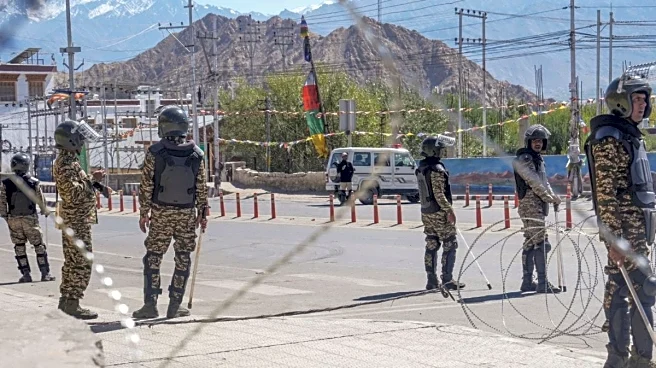Social tensions and violent incidents in Ladakh have posed a serious challenge to the peace of this remote and strategically important region. The causes of this tension are extremely complex, rooted in historical, economic, political, and cultural factors, and its resolution does not appear simple. There is no single reason behind the violence in Ladakh. Considering the region’s unique geographical and cultural conditions, a solid strategy is needed for its resolution. It is essential to address the economic and cultural concerns of the local population, consider their political demands, and promote peace and development while managing security-related challenges. Continuous dialogue and sustainable development seem to be the only viable ways
to maintain Ladakh’s delicate social fabric. Achieving this does not necessarily require granting statehood. Concrete steps are needed to earn the trust of the people under the Union Territory framework. The political and religious priorities of Leh and Kargil are distinct, and creating a state could deepen these differences. A state legislature might become a center of polarization rather than unity.
Concerns Of The People Of Ladakh And The Current Violence
After Ladakh was separated from Jammu and Kashmir and made a Union Territory, a strong political movement emerged here. At the heart of this movement is the demand for Ladakh’s inclusion under the ‘Sixth Schedule’.
Local residents argue that without a legislative assembly and Sixth Schedule provisions, they do not receive adequate autonomy over land, jobs, and culture. Protests over this demand have repeatedly triggered tensions.
Locals feel they are underrepresented in government jobs and other economic opportunities. Certain immediate events have also sparked episodes of violence. Prosperity does not depend on statehood; all these objectives can be achieved under the Union Territory framework with constitutional safeguards.
Why Granting Statehood To Ladakh Is Impractical
Since Ladakh became a Union Territory, some groups have demanded statehood. This demand has intensified recently due to the activism of certain leaders and organizations. But is statehood really a practical and safe option for Ladakh?
Considering all aspects, it becomes clear that Ladakh’s future lies not in statehood, but in strengthening the Union Territory framework with constitutional safeguards like the Sixth Schedule.
Ladakh’s vast area and small population of only 300,000 pose the first major challenge to statehood. Forming a legislative assembly for such a small population would be inconsistent and economically burdensome. For comparison, Puducherry, a small Union Territory, has 30 legislators for a population exceeding 1.2 million. Determining the number of legislators for a population of just 300,000 in Ladakh would be a significant challenge, and the associated costs would be disproportionately high.
A Better Future for Ladakh As A Union Territory
Direct central governance helps in swift decision-making in border regions. Establishing a state government could increase bureaucratic delays and complexities. As a Union Territory, direct central administration has assisted in decision-making and implementing development projects in Ladakh.
Forming a state government could hinder this efficiency by adding bureaucratic layers. Currently, per capita financial assistance from the central government to Ladakh is higher than most states, which is crucial for its development.
Ladakh’s prosperity does not depend on statehood. What it requires are region-specific economic policies, promotion of tourism and renewable energy, and strict reservation for local employment—all achievable within the current Union Territory framework.
Ladakh’s Borders With China And Pakistan
Ladakh is located along the India-China border, where the Line of Actual Control (LAC) has a long history of tensions. Clashes like those in the Galwan Valley directly lead to militarisation, adversely affecting the local population and fostering insecurity.
Due to the sensitivity of this region, security forces remain on high alert for cross-border terrorist infiltrations, leading to heightened vigilance and occasional disputes with locals. Granting statehood to Ladakh is neither practical nor in the interest of national security. Considering its small population and sensitive geography, decentralized power could be risky.
The best way to protect Ladakh’s interests is by empowering Hill Councils, implementing the Sixth Schedule, and maintaining direct central supervision, safeguarding its unique identity, environment, and security.
Addressing The Concerns Of Ladakh’s People
Tourism and animal husbandry are the main sources of livelihood for the people of Ladakh. Border tensions and security restrictions have disrupted these economic activities. Limited access to pastures and reduced income from tourism have fueled dissatisfaction. Basic amenities like healthcare, education, and communication remain severely lacking in remote areas. This slow pace of development creates a sense of neglect among locals.
Ladakh has a distinct Buddhist-influenced cultural identity. People, especially in the Leh region, are concerned about the increasing influx of outsiders and land transactions, fearing that it may harm their cultural heritage and demographic balance. The arrival of outsiders and expansion of tourism is also putting pressure on limited resources, especially water, creating competition between locals and outsiders.
Ways To Resolve Ladakh’s Issues Without Statehood
Grant LAHDC (Ladakh Autonomous Hill Development Council) more authority over land, employment, and resource management.
Strengthen Hill Councils and ensure protection under the Sixth Schedule.
Implement domicile-based reservation and a transparent recruitment process for locals.
Adopt region-specific economic plans, employment opportunities, tourism promotion, and sustainable energy models.
Enforce strict rules and laws to protect Ladakh’s fragile ecology and cultural heritage.
Trust Can Be Earned Through Effective Measures
Ladakh’s geographical position is extremely sensitive, bordering China and Pakistan. Any compromise on security and strategic interests is unacceptable. Granting statehood could affect military operations and logistics due to local government control over land use and infrastructure. The socio-political priorities of Leh and Kargil differ, and a state government could deepen these differences, turning the assembly into a center of polarization rather than unity. Nearly 97% of Ladakh’s population belongs to Scheduled Tribes. Constitutional protection under the Sixth Schedule is the most appropriate way to safeguard local culture, land rights, and employment. Strengthening the existing Ladakh Autonomous Hill Development Council (LAHDC) is a practical and effective solution.



/images/ppid_59c68470-image-175947254919829964.webp)
/images/ppid_a911dc6a-image-175950072378912015.webp)

/images/ppid_a911dc6a-image-175967233096726163.webp)



/images/ppid_a911dc6a-image-175942265722772200.webp)




